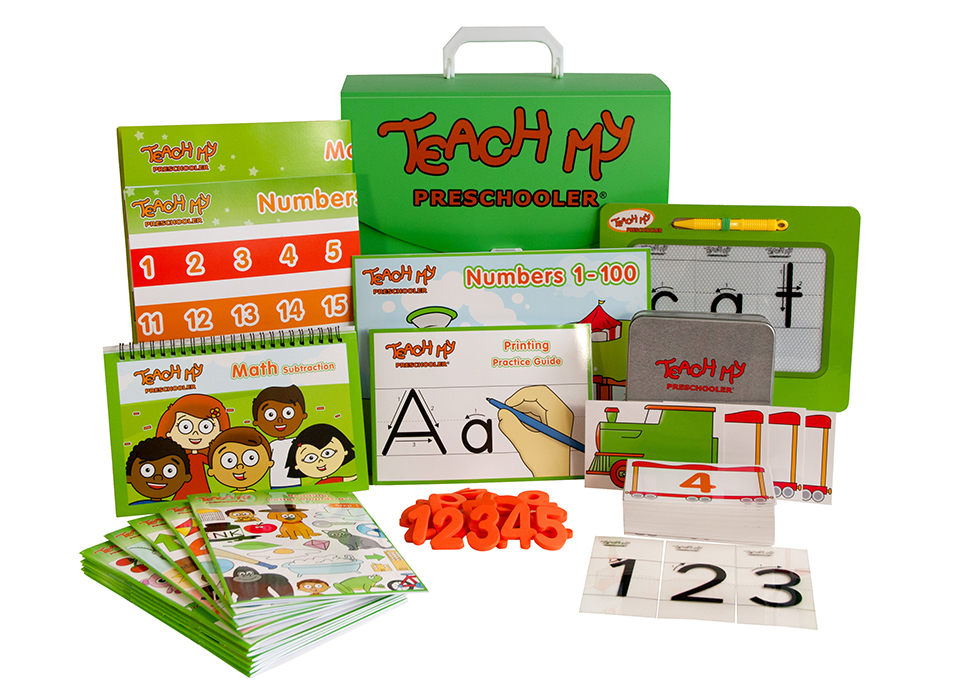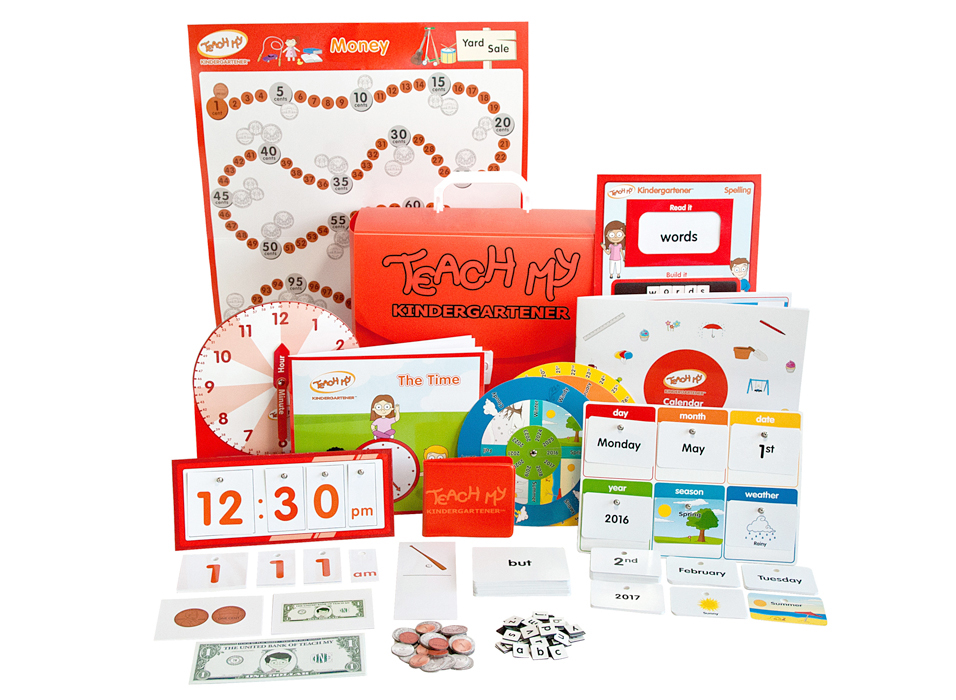Teach My Toddler, Inc. produces four kits: Baby, Toddler, Preschooler, and Kindergartener. Each kit comes in its own sturdy, vinyl storage box with a handle and clasp. Kits include traditional-style learning activities that are often taught with hands-on resources. A parent will need to work closely with a child, but the activities in these kits should provide enjoyable time together for both parent and child.
Components of each kit are grouped by subject area (four subject areas per kit) and are kept in four, heavy-duty vinyl pouches. Components were designed with consistent styles and colors for an aesthetically pleasing appearance. Beyond appearances, the consistency carries over into other areas that make learning easier for children. For example, in the preschool kit, the letter a is always presented to the child in the ball-and-stick font (ɑ) rather than the commonly used font. This same ɑ is taught in the handwriting lessons, it shows up in the readers, and it repeats on the reading flashcards. Attention to detail and integration of concepts across activities such as this are hallmarks of the Teach My kits.
All of the components are very well constructed. Most components have laminated surfaces and are sturdier than you might expect. Items like the spelling board and the clock face are constructed from heavy-duty materials that should be very durable. After looking over the items in the kits, I checked the website for prices. I was amazed to find a price far below what I would have expected for such high-quality kits.
Since I don’t generally review products for toddlers, I chose to review only the preschool and kindergarten kits. Both kits recommend that parents spend only about 20 minutes a day working on kit activities, so these are not meant to be complete programs. A ten-page teaching guide in each kit explains how to use kit components. Teaching guides recommend choosing just one area a day on which to concentrate.
Teach My Preschooler
 Teach My Preschooler, designed for ages three and up, includes four vinyl pouches for reading, printing, numbers 1-100, and math.
Teach My Preschooler, designed for ages three and up, includes four vinyl pouches for reading, printing, numbers 1-100, and math.
Teach My Preschooler assumes that children will have already been exposed to the alphabet and can name the letters. The reading portion of the program presents a list of the letters of the alphabet on one page for review, then it begins to teach the sounds of the letters. Reading instruction is intended to be introductory rather than thorough.
Ten full-color reading books are to be used interactively. The parent teaches through the first six books, following the scripted “Teaching Tips” on most pages. At the ends of the first three books are sentences with illustrations that the parent is to read aloud with the child following along. The child is learning that sentences flow from left to right. They might recognize and be able to read words that were presented in earlier lessons, but don’t count on that. The fourth, fifth, and sixth readers each have pockets in the back with flashcards. The flashcards and these readers, together. teach 20 short-vowel words, 20 long-vowel words, and 20 high-frequency words such as and, in, the, and went. The last three readers present illustrated reading material that uses only the sixty words introduced in the previous books. The reading pouch includes a tin container in which students can place flashcards they have mastered.
While preschoolers will probably learn to recognize some of the words by sight and grasp some of the phonetic concepts, I would not expect most preschoolers to be able to read complete sentences without assistance. Keep in mind that reading instruction is supposed to give preschoolers a head start on what they will be learning in kindergarten, so do not expect mastery.
The printing pouch contains its own brief teaching guide, a magnetic drawing board with a stylus, and traceable transparencies for upper- and lower-case letters as well as numbers.
The numbers 1-100 pouch has a set of foam numbers (0 through 9), a poster showing numbers up to 100, a set of laminated cards with numerals for 1 to 100 on one side and the number words written out on the reverse, and an illustrated book that teaches numbers in groups of ten up to 100. Working with a parent, children will use all of these components to learn to identify numbers and their progression. For example, they can use the foam numbers to recreate the numbers in the book, or they can use the poster to check themselves as they line up all of the cards from 1 to 100 into one long train.
The math pouch teaches addition and subtraction using foam numbers (a second set is included in this pouch) along with plus, minus, and equal signs to make equations. Five foam counters are used with a flip book to learn addition and subtraction in a hands-on fashion. A large, two-sided poster is also used with foam counters to practice addition and subtraction.
While Teach My Preschooler does not serve as a complete preschool program, it does introduce academics, providing activities for repetition and practice that are likely to help children lay a foundation for academic work. However, parents need to be cautious not to push too fast with children who are not yet ready for academics and might benefit for further pre-learning skills such as fine-motor control, listening skills, and identifying shapes and colors.
Teach My Kindergartener
 According to the publisher’s website, Teach My Kindergartener was created to “promote school readiness and a head start for kindergarten.” The four pouches in this kit teach spelling, money, time, and the calendar. One might expect to find reading in that list, but reading skills are only taught through spelling.
According to the publisher’s website, Teach My Kindergartener was created to “promote school readiness and a head start for kindergarten.” The four pouches in this kit teach spelling, money, time, and the calendar. One might expect to find reading in that list, but reading skills are only taught through spelling.
The spelling pouch is designed for teaching the first 100 words from the Fry Word Lists (created by Dr. Edward Fry). These lists include the most common words used in both reading and writing. Teach My Kindergartener teaches children to recognize these words by sight rather than by using phonics.
To that end, the spelling pouch has flashcards and magnetic letter tiles along with a specially designed spelling board. Choose one of the 52 flashcards and insert it into the slot on the spelling board. (The 52 cards have words on both sides, and there are two blank cards to add your own words.) After students have read the word, they locate the correct letter tiles to spell the word on a magnetic strip on the spelling board. Then students print the word below the tiles with a wipe-off crayon. (Two wipe-off crayons included with the kit are used for this activity as well as with activities in all of the other pouches.) They continue working in this fashion with all 100 words.
The money pouch has play coins and bills for students to work with, and flashcards teach the values of each bill and coin. Another set of cards has images of items to buy and space for you or your child to write a price with the wipe-off crayon. A money poster shows how different combinations of coins can add up to amounts under one dollar. Using a section at the bottom of the poster, children can practice with the item cards with prices, finding the correct coins. Students can use the play wallet in the pouch to store coins and bills then role play purchasing items. I know that children love playing store with money, so I expect this pouch will be the one they want to use most often.
The time-telling pouch teaches children to read both analog and digital clocks. You can introduce telling time with the colorful book that comes in this pouch. Heavy, laminated pages each show a particular activity, such as bedtime, with a blank clock where students can show the time it would take place. The book is first used as a teaching tool to explain time, analog and digital clock faces, and the concept of a.m. and p.m. Parents might show children how to write the time at first, then children can later practice doing it on their own. The large analog clock face has movable hands and includes numbers showing the minutes around the clock rather than just lines. There is space at the bottom of the analog clock for children to write the time in digital notation. The separate Digital Time Maker is set up like an old-fashioned scoreboard, with pegs for mounting the hole-punched number cards.
The calendar pouch helps children learn about both the calendar and weather. Two three-layer spinners allow children to indicate the month, day of the month, and day of the week on one spinner and the year, the season, and the weather on the other. They can identify these same six things on the stand-up Date Maker board. Like the Digitial Dime Maker, this board has pegs on which children hang cards for each thing they identify. A wipe-off calendar book has a page for each month. Children can write in the dates and the year then add special events as they wish.









